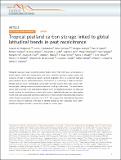Tropical peatland carbon storage linked to global latitudinal trends in peat recalcitrance
Author(s)
Hodgkins, Suzanne B.; Richardson, Curtis J.; Dommain, René; Wang, Hongjun; Glaser, Paul H.; Verbeke, Brittany; Winkler, B. Rose; Cobb, Alexander R.; Rich, Virginia I.; Missilmani, Malak; Flanagan, Neal; Ho, Mengchi; Hoyt, Alison M.; Harvey, Charles F; Vining, S. Rose; Hough, Moira A.; Moore, Tim R.; Richard, Pierre J. H.; De La Cruz, Florentino B.; Toufaily, Joumana; Hamdan, Rasha; Cooper, William T.; Chanton, Jeffrey P.; ... Show more Show less
DownloadPublished version (1.344Mb)
Publisher with Creative Commons License
Publisher with Creative Commons License
Creative Commons Attribution
Terms of use
Metadata
Show full item recordAbstract
Peatlands represent large terrestrial carbon banks. Given that most peat accumulates in boreal regions, where low temperatures and water saturation preserve organic matter, the existence of peat in (sub)tropical regions remains enigmatic. Here we examined peat and plant chemistry across a latitudinal transect from the Arctic to the tropics. Near-surface low-latitude peat has lower carbohydrate and greater aromatic content than near-surface high-latitude peat, creating a reduced oxidation state and resulting recalcitrance. This recalcitrance allows peat to persist in the (sub)tropics despite warm temperatures. Because we observed similar declines in carbohydrate content with depth in high-latitude peat, our data explain recent field-scale deep peat warming experiments in which catotelm (deeper) peat remained stable despite temperature increases up to 9 °C. We suggest that high-latitude deep peat reservoirs may be stabilized in the face of climate change by their ultimately lower carbohydrate and higher aromatic composition, similar to tropical peats.
Date issued
2018-09Department
Massachusetts Institute of Technology. Department of Civil and Environmental EngineeringJournal
Nature Communications
Publisher
Springer Science and Business Media LLC
Citation
Hodgkins, S.B., et al. "Tropical peatland carbon storage linked to global latitudinal trends in peat recalcitrance." Nature Communications 9,1 (2018): 3640. https://doi.org/10.1038/s41467-018-06050-2 © 2018 Author(s)
Version: Final published version
ISSN
2041-1723